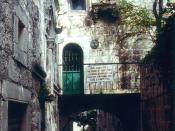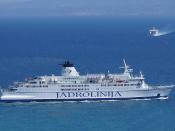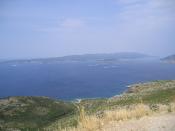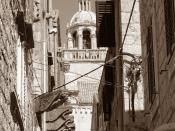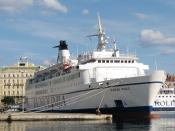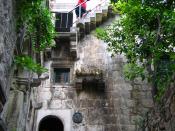Introduction Many tales have been spun from Marko Polo and his stories of his life adventures exploring the Far East. History will never truly know what was fact and what was fiction, the truth lies only and died with Marko Polo himself. But, history was also altered by the yarns of Marko Polo as his maps and descriptions of the east influenced the likes of Christopher Columbus in the quest to prove that the world was in fact round. Who was Marko Polo? He was the son born of a mercantile trader in the 13th century, but after that, it becomes harder to nail down the truth of the rest. He has been called an Italian#, a Venetian#, an exaggerator, the first journalist or at least first adventure travel story teller, maybe he started globalisation by linking civilizations and sharing inventions, maybe he was even a Croatian, but in the end, he was definitely an adventurer and has been an inspiration to generations centuries over.
In our present world the name of Marko Polo can be found just about anywhere; on schools, hotels world-wide, museums, travel agencies, streets, maps, books, and towns/villages. His name is so widely used that most of the world's population know of him in one or the other way. Marco definitely earned his reputation. He is perhaps the biggest explorer of all times. Some say that it was Marko Polo who changed Europe's history. To narrow impoverished mediaeval Europe, Marko tales of the Far East revealed incredible wealth of knowledge, inventions of whole new civilizations. His travels inspired many to go and explore the world. Some of these explorers include Christopher Columbus who instead of finding an easier route to China stumbled and discovered America. Marko's discoveries of new land where knowledge and culture were part of daily lives dynamited Europe's walls of ignorance and later on inspired the great cultural flowering today known as a Renaissance.
There is some argument over which country can claim Marko Polo as their own. Of course, it is quite an honour to lay claim to one of the world's most famous explorers. To Italians he is Italian, according to National Geographic (world's leading scientific magazine) he is Venetian# and in history books throughout the world he is either Italian or Venetian. The name Italy denotes the unity of all small city-states in that region and first appeared in 1861 as a Kingdom of Italy#. Therefore, Marko Polo, who was born in 1254, couldn't possibly be Italian since it did not even exist when he lived or when he died, over 700 years ago. His second citizenship of Venetia can't be right either since he wasn't born there. According to few Italian historians Marko was indeed born on Korcula. Their opinion was based on the fact that Marko's father Nikola wasn't returning to Venice between 1250-1269. Since we all agree on the year 1254 that Marko was born he couldn't possibly been conceived or born in Venice#. He later became Venetian citizen, but he was actually born in a small costal village named Markovo near the city of Korcula (where he later moved), on the island of Korcula in Dalmatia#. Dalmatia is a province of Croatia. So why all this confusion for such important figure? And why can't Marko be what he actually was? Is it that typical European greediness where smaller nations have to give up all they are proud of to their bigger and stronger "friendly" neighbour? The city of Korcula is today known as one of the most attractive and best preserved towns from the middle Ages in the Mediterranean region#. The island of the same name is one in the long string of pearls forming great archipelago that runs along the eastern coast of the Adriatic Sea. Throughout my schooling in Split, Croatia, I knew only of Marko Polo as the greatest Dalmatian traveller of all times. It was when I left Split, in 1991, and spent five years cycling around the world on my bicycle promoting Peace in Croatia that I soon found out that my travel inspiration and countryman, Marko Polo, was claimed by others and no longer my own countryman.
Henry S. Hart is one of those who tried to come up with Marko's true background. In his book "Venetian Adventurer: Marco Polo" he carefully describes Marco's family origins#. According to his book, Polo arrived from Sibenik, Dalmatia . Later, the family moved to Korcula which became Marco's birth town. In the 13th century, Korcula was the Dalmatian center for ship building and trading. In order to have better access to wealthy city-states on the other side of Adriatic (mainly Venice) Korcula's merchants used two names; Latin as citizens of Venice and their own Croatian name while among their countrymen In most of Croatian history books Marko's full name is Polo-PiliÃÂ Marko#. Marko's coat of arms is made of four chickens. In today's Italian 'polo' means chicken and in Croatian 'pilic' means chicken. Marko's coat of arms is registered in Korcula.
Another proff of Marko's birth place is in Encyclopedia Britannica which states that Marko was born on Korcula, Venetian Dalmatia#. Marko's father and uncle had established a successful trading outpost on their island of Korcula. At that time, Venice was one of the strongest centers of commerce in the Mediterranean. However, Marko spent first seven years of his life with his mother and other relatives at his home in Korcula. His house in Korcula, the one he was born in, is still standing and is in very good condition.
Another researcher on Marko Polo, Sir Henry Yule, goes even further in describing Marco's background in his book "Ser Marco Polo"#. To further straighten the argument of his Croatian connection Sir Henry noted that Marko;s daughters each married men by last names Bragadin and Doliln, which are typical Croatian last names and not Italian. Marco's genealogy also listed a brother married to a Sagredo-this Sagredo is registered in Dalmatian nobility. The Croatian Census of Population for 1948 lists Depolo (De-of Polo) on the Island of Koruna with 40 individuals in 15 families and the city of Drnis, Dalmatia approximately 20 km from Sibenik (the origins of Polo) has over 25 families with more than 130 individuals named Pilic".# James A. Gilman from the British Museum has presented a 14th century document to the Marko Polo Centre of Korcula linking Marko Polo with Dalmatia.# Another proof of Polo coming from Korcula is from the Encyclopedia Treccani which states that famous sculptor Corinth Polo lived in Korcula in the 5th century B.C.# At that time Korcula was the main Illyrian stronghold in the Adriatic. Polos original documents indicate their Venetian citizenship starting in 1295 which indicates their immigration from another place, possibly Korcula#. In Andjelko Nedo's "Etnic origin of the explorers Pols (alias POLO-s)" author concludes: " Giovanni Orlandini, the Venetian authority on our subject writes in 1926. that the genealogy of the Polos is not "chiara" (clear). He asserts that their genealogy is traceable in Venice as from the middle of the XIIIth century. He believes that the Polos had been gradually coming from the Near East ports and settling, after the year 1261. in Venice in the consequence of the Near East Latin Empire#. In another article from Britannica the author stated about Marko's birth place "Nothing is known of his early years in Venice, although it seems fairly certain that he learned little or no Latin"#. Which could be explained by his upbringing in Dalmatia.
When Marko Polo traveled to the Far East, 750 years ago, Europeans didn't know anything about the vast land of the Far East. They knew about India from their traders-sailors but anything beyond India was a mystery. Westerners had some ideas of India since the glory days of Alexander the Great#. They may have later heard stories from south European seamen who traveled through the eastern parts of Mediterranean and the Black Sea and would have heard rumors about the magnificent land far-away on the east. But it wasn't until 1300's that someone had enough courage to endure a visit to China. Marko was full of joy once he learned that he was going with his father and uncle. So in the early summer of 1271 Marko, at the age of seventeen, started his voyage from the port of Venice. Little did he know that he would not return for over twenty four years. Sailing along the eastern side of the Adriatic Sea, which was the usual way for Venetian galleys to travel, Marko passed by his native Korcula to greet relatives and friends#. Contrary to all previously heard rumors they didn't come across any sea monsters or Muslim pirates during their travel across Mediterranean. Their first major stop was Acra, a Palestinian headquarter, where they obtained proper diplomatic credentials and letters for the Mongol emperor. From that point on they were also accompanied by two missionaries. The two Catholique monks/missionaries soon died and Polos had to continue their mission alone.(Lantham, 1958, p.14) #. Marko Polo's uncle and father had promised to return to China with Christian priest at the request of the Mongol Emperor. The next big stop was Baghdad, although some historians claim that to be Hormuz. These historians defend their theses simply by observing how Marko described the Mediterranean blue colors from that city's river. It is commonly known that river Tigris that flows through Baghdad has the color of mud#. From the heat of Baghdad they continued through the long portion of stretches of salt desert where their lives depended greatly on few and far between oases. Water was used very strictly and in some cases they carried enough of life's fuel for a whole week. Slowly they were approaching the great mountain range that lied at the heart of Asia and which made air fresher and travel easier. Marko enjoyed watching big mountain sheep and to this day, those sheep are named "Polo's sheep" in his honor.# Next big challenge was the Gobi desert. It is well known for its poor and rare oasis and little or no vegetation for animals or birds. Up to this point, most of the people they met had were followers of Mohammed. Few were Christians and the third class were those who worship idols.# He couldn't understand these new religions but he enjoyed their ceremonies and festivals. After the city of Kerman, where Marko became quite ill and had to stay for almost a year# to recover, they continued their travels along the famous Silk Road. Along with providing a trade route with China, the Silk Road was also the way which both Buddhism and Nestorian Christianity were using to spread their religions. Marko did an excellent job of recording many new things along the road he traveled. He was particularly talented at gathering information and noting particularities of local animals, food, spices, customs, art, and plants. He was also great geographer; it was Marko Polo who was the first traveler to trace a route across the whole longitude of Asia.#. Their main transportation consisted of ox, horses, wagons and camels.# After forty days of traveling over the Himalayas they finally reached the city of Kashgar, the most westerly city of Cathay (China).# They were empowered with this triumph and a couple of months later they encountered even bigger surprise-the Great Wall of China.# News that Polos were coming had reached the Great Khan at his summer palace of Shang-Tu. The Great Khan sent his representatives on a forty days journey to find the Polos and bring them to him. The Polos presented him with the Holy Oil from Jerusalem and the letter from the Pope Gregory X. Kubilai was impressed by Marko's intelligence and especially his fluency of Mongol language. Marko soon became one of his governors and served him for the next twenty years. It was the year of 1292 when Kibilai asked Polos to escort princess Kokachin to far away Iran. They were given fourteen ships and enough supplies for two years and also letters for the Pope. They arrived to Venice in 1295, the year Great Khan Kubilai passed away in far away Cathay.
Three years after Marko returned to Venice, he commanded a galley in a war against the rival city of Genoa. That battle was one of the biggest in the middle Ages. It took place near Marko's native Korcula. The Venetians had sent 96 galleys and three big ships against 85 galleys from the Genoese. Contrary to all expectations Venetian vessels were either captured or destroyed including the Polos. Marko was then captured and taken to a Genoa prison where he spent a year. It was during his imprisonment, that he met Rustichello, the writer from Pisa to whom Marko started to dictate his memories of the wonderful travels to China. His book known as "Il Milione" became one of the most popular books in medieval Europe. His book also had tremendous impact on contemporary Europe. If the battle before his native Korcula hadn't taken place his Il Milione might never have been written! If there is anything to conclude after reviewing the literature on Marko Polo, it is that there are many who lay claim to having the honor of calling this most famous of famous travelers, their own. It really isn't all that important where he was born exactly or where he identified himself as coming from, but in the wealth of his travels and what richness he brought to the west by his travels. Perhaps it is sufficient to throw shadows of doubt as to whether or not Marko Polo can be claimed by Venice or modern day Italy as their own. Many people are born in countries where they do not feel a deep connection as they grew up in another location or emigrated and settled somewhere else. Marko Polo was indeed born on the island of Korcula, in the Croatian state of Dalmatia. That makes him a Croatian and it is documented that his family roots came from Croatia. However, after their travels Marko's father and uncle settled in Venice#. Therefore they are often misidentified as the "Venetian" or "Italian Polos". The role of city-state of Venice for the Polo's should not be disputed. All historians agree that Korcula was part of the Serenissima government for centuries which ultimately helped Korcula to prosper and grow. It can be argued by Dalmatian Croats that Marko Polo is one of their own but above all he is the property and inheritance of the entire world.
His wonderful stories described our world population with all richness having different races and cultures. Furthermore Marko tried to teach us about the importance of getting in contact with as many other people as possible in order to develop true relationships with them and not against them. And that is exactly what Korcula's Marko Polo-PiliÃÂ was doing throughout his travels. His name therefore represents probably the strongest bridge for cultural exchange between East and West. His name has potential to increase the understanding and friendship between East and West. His stories, fiction or not have captured readers through the centuries. Today there are more than 80 manuscript copies in various versions and many languages around the globe#.
It is unclear until this day where Marko spent his childhood. It seemed that his father Nikola saw him first time in Venice in 1269. Marko's birthplace is unknown so we can all argues about it. His roots are very likely from Croatia#. He was one of the first European diplomats in China. Due to his historical accomplishments Marko Polo-PiliÃÂ was the world-citizen of the Croatian descent#.
